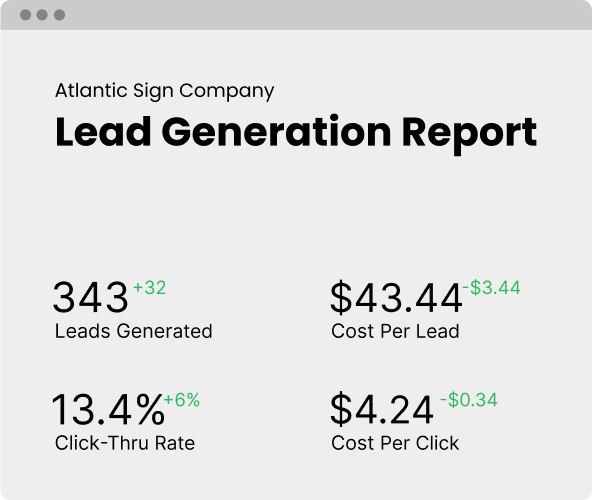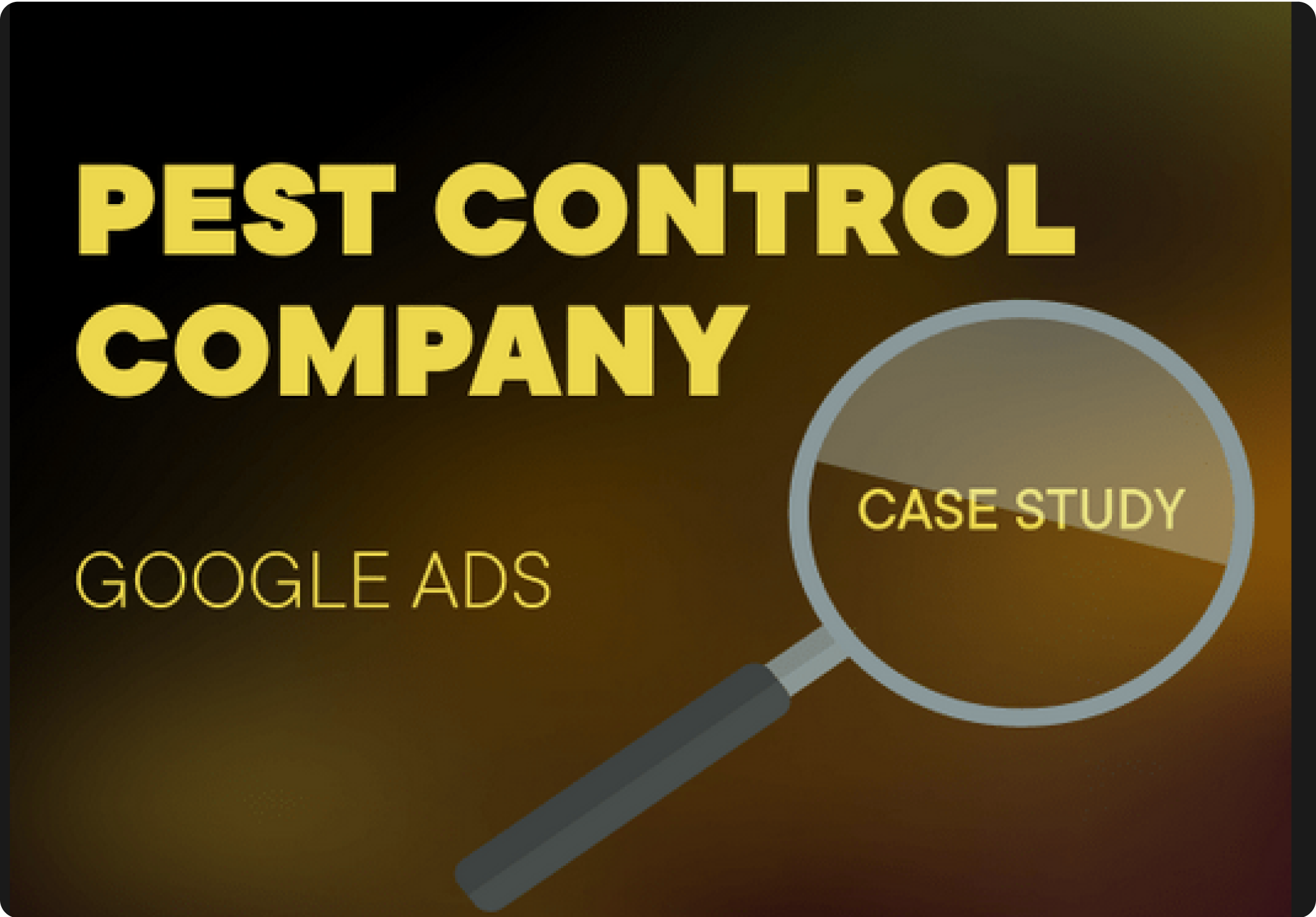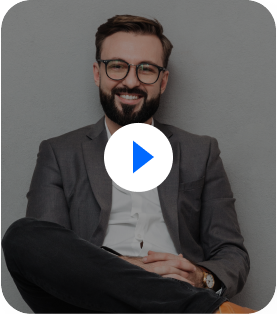








Pay Per Click Advertising through Google Ads is a fantastic strategy to generate immediate, scalable sales for your business.
Here’s what we accomplished for Atlantic Sign Company

Data driven strategies to pinpoint the best converting keywords for your business.
Our technical team sets up conversion tracking and begins building your campaigns.
Our expert ad strategists meet with you to review your campaigns prior to launch.
We build out the best converting ads and copy to set your campaign up for success.
First we dig into your Google Ads account with a full audit. We’ll analyze everything to ensure we have a clear understanding of whats needed to improve and scale.
Based on our audit, we’ll develop a data-driven strategy aimed at increasing traffic, impressions, and conversions.
Now it’s time to take action. We begin running the campaign to collect data, optimize, and drive growth. Our services, starting at $1,000/month, are designed to scale and adapt to your growing business needs.
Now it’s time to take action. We begin running the campaign to collect data, optimize, and drive growth. Our services, starting at $1,000/month, are designed to scale and adapt to your growing business needs.
When you work with us, you’ll always know exactly how much businesses is being generated by our SEO progress. Your dashboard will be detailed and easy to understand.
Whether it’s 7AM or 9PM, we’re always in our inbox and available to answer questions about your marketing campaigns.

Hey, everyone. I’m Scott Keever of Keever SEO, and welcome to my complete guide on pay-per-click (PPC) marketing.
I’ve been doing Google PPC for 10+ years for local and national businesses. And I’ve written about search engine marketing for Forbes, Fox, Yahoo Finance, and dozens of other online marketing outlets (that you’ve probably never heard of!)
Go open a new tab and Google a search term related to your business. A good example is “(your industry) near me”.
If not, PPC marketing could change that in as little as 24 hours
Pay-per-click advertising is a proven way to generate high-quality leads on demand at relatively low prices. This is because it puts your business front and center as the #1 search result when people Google “buy-now” terms related to your business.
In this guide, I’ll teach you everything you need to know about Google PPC ads. Including:
Pay-per-click (PPC) is a form of online advertising where businesses pay to display ads on the Google search engine results page (SERP). When someone searches for one of your chosen search terms, Google shows them your ad, and you pay every time a user clicks on it. It’s sometimes referred to as the CPC (cost-per-click) model.
When done properly, paid advertising can generate revenue very quickly because it puts your business directly in front of customers who are actively searching for products and services that you offer.
An example of PPC advertising is a tree removal service running ads in their local area any time someone searches for “tree removal service in (location)”. Here’s a good screenshot of PPC in action:

Pay-per-click (PPC) is a form of online advertising where businesses pay to display ads on the Google search engine results page (SERP). When someone searches for one of your chosen search terms, Google shows them your ad, and you pay every time a user clicks on it. It’s sometimes referred to as the CPC (cost-per-click) model.
When done properly, paid advertising can generate revenue very quickly because it puts your business directly in front of customers who are actively searching for products and services that you offer.
An example of PPC advertising is a tree removal service running ads in their local area any time someone searches for “tree removal service in (location)”. Here’s a good screenshot of PPC in action:

In pay-per-click advertising, you choose specific search terms (“keywords”) related to your business that you wish to display ads for. Then, you create a “display ad” related to that search term. When people Google one of your chosen keywords, your ad will display at the top of the SERP if you outbid your competitors.
Let me explain why…
Google PPC works via an auction system. Businesses “bid” against each other to determine which ad will be displayed to users. When someone searches for a key term, businesses “bid” and the winner gets placed as the first result on the SERP.
Don’t worry, you can set a maximum daily budget. Once you set your budget, you’ll no longer enter your bid at the auction once you reach that limit.
That’s pretty much it in terms of PPC ads. You choose your key terms, create your ads, then begin bidding to get your items displayed in the search results.
How is PPC Beneficial to Your Business
Immediate traffic
Highly targeted traffic
High-intent traffic
It all boils down to this: PPC lets you reach high-quality leads that are ready to buy from you as quickly as the same day.
With other forms of online advertising like search engine optimization (SEO) or social media marketing, it could take months of consistent effort to start seeing ROI. It would be worth it, but that’s a long time.
With paid ads, your business can jump straight to the top of the search results in as little as 24 hours and place ads directly in front of customers who are actively searching for products and services.
That, and you can specify the types of customers you wish to advertise to right down to their age, demographic information, and location.
If you want to reach potential customers immediately, running Google ads is the best form of advertising there is.
Let’s cover some more of the benefits of paid Google ads before moving on to my process for building a high-ROI PPC campaign:
Pay-per-click is the fastest and simplest way to get more visitors to your website immediately. With PPC, you’re essentially paying Google to jump the line to the top of the results.
All you need to do is select your keywords, determine negative keywords (more on this further down), and create your ad copy. Then, you just set a budget and you’re ready to go. This whole process can take as little as a week.
Paid advertising gives you the ability to target your ideal customer right down to their buying intent, location, age, gender, and household income.
I think the benefit is clear here. With PPC, you aren’t just placing an ad to a cold audience of random people. You can target your ideal customer, which drastically increases your ROI and reduces ad spend (due to not wasting money on uninterested leads).
Google shares an example on its Google Ads Help support forum that demonstrates this ability perfectly. “Alberta” is a businesswoman who runs a blog for working moms. She uses Google Ads to tailor her advertisements directly to her most valuable target audience, increasing her conversion rates and improving ROI.
She shows her ads only to women with kids ages 25-54. But that’s not all, she also zeros in further and targets women in the top 30% of US household incomes who are in the market for baby products.
See the power here? This type of targeting is what gives Google Ads an 8:1 return on investment ratio on average, according to research published by Google on their Economicimpact.google platform.
With PPC ads, you can target:
Age
Gender
Household income
Parental status
Location
Language
Interests
In-market audiences (people actively searching for products in your niche)
Life events
Remarketing (people who’ve interacted with you before but didn’t purchase)
Another significant benefit of paid ads is that they target “warm” leads, or people who are looking to buy your products or services immediately.
Remember the example above about the tree removal service? Someone who Googles “tree removal near me” is obviously looking for someone to cut that annoying tree in the front yard down immediately.
That’s why conversion rates for Google Ads are usually well above that of other advertising methods.
Google Ads allow you track a bunch of helpful metrics that you can analyze and optimize. This eventually leads to higher conversion rates and lower costs as time goes on.
Google allows you to track metrics like ad performance, cost per click, conversion rate, and performance over time. My team and I are regularly analyzing our client’s data, running tests, and optimizing ad performance to improve conversions.
This isn’t possible with most other forms of advertising.
Google Ads are a stable form of advertising that consistently generates income over time. And, if done properly, ad performance should only increase rather than decrease.
Platforms like Google, Facebook, and Instagram are constantly changing their “organic” (unpaid) ranking algorithms, which means that websites or accounts are constantly gaining or decreasing visibility depending on dozens of different ranking factors.
But Google loves nothing more than when you pay them to rank in their results. As long as you keep paying to stay at the top of the rankings, Google has no reason NOT to show you. In fact, they encourage it.
With PPC, you can control how much you spend per day, per month, or per year. You don’t have to spend more than you’re comfortable with. Once you set a budget, the algorithm will cease displaying your ads after that budget is reached.
This gives you maximum cost control in your advertising. With other forms of advertising like SEO, you need to keep investing with no guarantee of results. With PPC, you can start small, earn some money (assuming you do it right), and wait until you have the budget to scale up.
Some companies start with $50 per day or less and only scale up their ads once they’ve actually made some profit. With other forms of advertising, you need to invest large amounts of money up front before you can hope to earn anything back.
I hate to sound like I’m overselling it to you, but PPC takes a lot less UPFRONT work than other “long-play” forms of online marketing like SEO. Most of the work in PPC comes after your ads are live.
With search engine optimization, you need to optimize your site, build a content strategy, publish a lot of content, and perform intensive link-building campaigns to even hope of ranking on Page 1.
With paid ads, you just pay to be placed at the top spot.
Now, there are drawbacks, of course. Nothing is ever guaranteed. Some keywords can be quite expensive and competitive keywords can eat up a budget very quickly, so you need to be careful.
PPC Ads Can Improve Your SEO
One major benefit of PPC ads that’s often overlooked is that they improve “organic” – or unpaid – SEO rankings. These are the “natural” rankings your business has in the Google search engine.
Most business owners think they should invest in either PPC or search engine optimization, but in reality, you should be doing both. They naturally compliment each other.
Here are a few ways that running paid ads can boost your natural rankings:
Occupy More Real Estate: Taking the top spot means you’re taking away from competitors. According to WebFX, 65% of users click on ads while looking to purchase something. Those clicks go to your site instead of a competitor’s site, which sends positive signals to Google that could help rank you over competitors naturally.
Better User Behavior Signals: Google uses user behavior signals like bounce rate, click-through-rate, and time-on-site to judge whether or not your site is a good result for a search query. If users click your ads, stay on your page, and take action, this sends more positive signals to Google that you’re a good business that should be ranked above others. Also, Google measures return visitors, almost like a form of brand awareness. If users continue to recognize you and come back to your site, this tells Google that you should be ranked higher for more keywords.
Discover Better Organic Keyword Opportunities: PPC ads bring in fast traffic, so you get immediate feedback on what’s actually working for your business. With paid ads, you can quickly see if a keyword is bringing in high-quality traffic or if it’s not working out. You can then use this data to find different groups of organic keywords to attack in your SEO strategy. If you were just doing organic SEO, it would take months to get enough traffic to make this type of testing. Paid ads? Days at most.
The key difference between SEO and PPC is that SEO is a long-term play for naturally ranking your website that requires up-front work whereas PPC is an immediate marketing method for driving traffic to your website.
I’ll start by explaining the benefits and drawbacks of SEO first.
Search engine optimization is the process of optimizing your website, content, and off-site brand (e.g, social profiles) to send positive signals to Google that boost you up in the rankings. This could take a few months to produce ROI, but once it does, the benefits are exponential.
Organic search results have much higher click-through-rates from users than paid results. And consistently ranking for search terms creates massive brand awareness that improves conversions. And, once your site is ranking for multiple keywords, Google naturally boosts you up for other keywords as well. So, it’s essentially “free rankings”. With paid ads, you’d have to pay to rank for each of those key terms.
Paid ads are the opposite. Instead of putting in the work to optimize your site for that natural boost, you just pay to jump the line and get listed at the top. The downside to this is that you pay to rank for each key term. If you have the budget, however, this will drive the fastest results and give you immediate ROI.
OK, let’s get into the nitty gritty details of how to run your own high-converting PPC campaigns from scratch. I’ve got some good news: It’s really not that hard once you know what you’re doing.
In this section, I’m going to cover how to set goals, choose the right campaign types, select the right keywords, improve your ad copy, and analyze all of the valuable data that Google gives you.
This is the exact same process I use with my clients at Keever SEO. These steps are what helped me achieve the following results for one of my clients:
Warning: PPC is the best way to generate leads and sales as quickly as possible. But if you do it wrong, it could get very costly, very quickly. For example, if you target the wrong audience, you’ll be paying for ads with 0% chance of converting. That’s going to be a sad bill to pay each month. And worse, bringing in the wrong traffic could kill your SEO game, just like how bringing in the right traffic could boost you up in the rankings. So, make sure you read through this section and make sure you run your campaigns carefully.
Targeting a very specific customer with a perfectly tailored ad is the best way to get quick wins with PPC ads. The more general your ad, the lower the conversions will be. I find that getting quick wins and seeing more clicks and sales is ultra-motivating. Once you see the money rolling in, you’ll be motivated to run more ads and optimize your campaigns.
The best ways to target a specific customer are:
One underutilized tip for improving PPC campaign conversions is using ad extensions. Ad extensions are pieces of information like links, star ratings, callouts, phone numbers, or hyperlinks to other areas of your website or important information. These have proven to greatly increase click-through-rates and conversions.
Here’s a good example of extensions from an ad for “women’s dresses”:
I’ved used a lot of PPC terms in this article that may be confusing to you. So, if you’re struggling to even know what to look for in a campaign, just start by tracking these:
PPC ad campaigns can be extremely profitable when done properly, but they come with a ton of challenges – especially for businesses that aren’t familiar with online marketing.
If you’re struggling with any of the following PPC issues, Keever SEO can help:
Top businesses are winning because they have a single source of truth for their
reputation performance. They always know what consumers are saying










Top businesses are winning because they have a single source of truth for their
reputation performance. They always know what consumers are saying

Top businesses are winning because they have a single source of truth for their reputation performance. They always know what consumers

Top businesses are winning because they have a single source of truth for their reputation performance. They always know what consumers

Top businesses are winning because they have a single source of truth for their reputation performance. They always know what consumers

Top businesses are winning because they have a single source of truth for their reputation performance. They always know what consumers